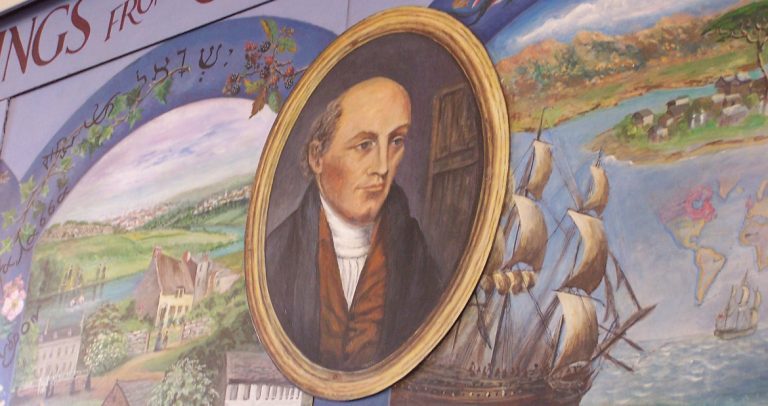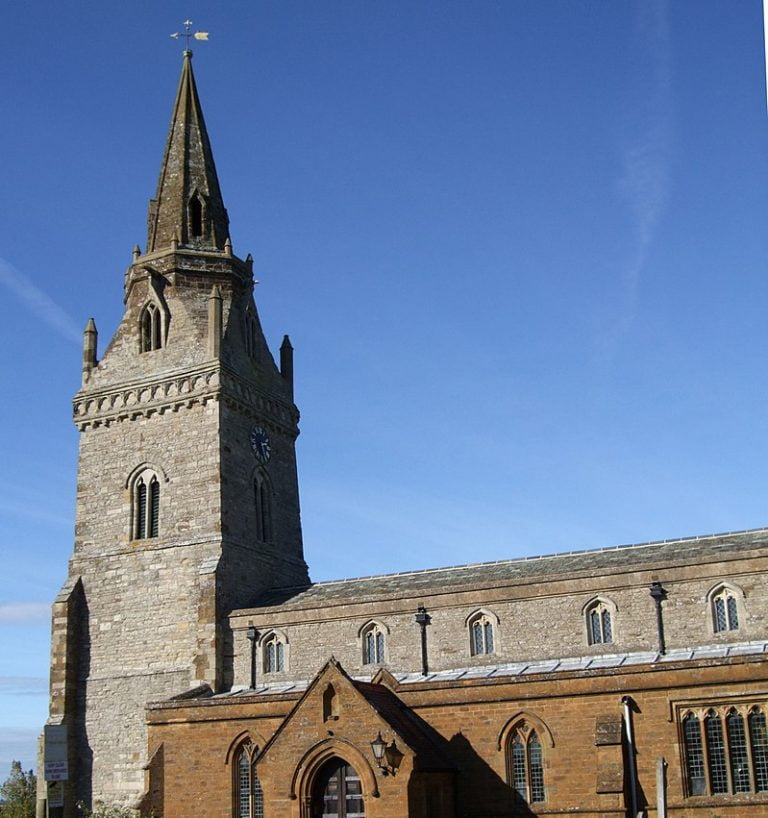Favorite
At Doddridge Street (NN1 2RN) is Castle Hill United Reformed Church, once known as Castle Hill Church, where the independent Congregationalist, Phillip Doddridge (1702-51), served as pastor. While Doddridge’s compromising endorsements led many young men toward erroneous doctrines, his songs, such as “O Happy Day,” and his classic book, The Rise and Progress of Religion in the Soul (1745), are still in use. Read more...
Favorite
John Collett Ryland Sr. (1723-92) and John Ryland Jr. served the pastorate of Northampton’s College Lane Baptist Church (built in 1697). The church became College Street Baptist Church, in 1863, when the congregation erected a new building on the same site. The church would later close, but, on College Street, one can admire this magnificent building’s classical facade of Corinthian pillars. Read more...
Favorite
On October 5, 1783, William Carey walked five miles from Piddington to Northampton, for John Ryland Jr. (1753-1825) to immerse him in the River Nene at 6:00 AM. he was baptized on the spot where the modern railway station is now located. The construction of the station necessitated the rerouting of the River Nene. Carey’s baptism took place where the Read more...
Favorite
The Baptist church at Thrapston, Northamptonshire, was once shepherded by Reynold Hogg (1752-1843), one of the founders of the Baptist Missionary Society (1792). With the construction of the present building, in 1787, a small, Congregationalist-Separtist group opened its doors for worship. In 1790, Reynold Hogg became their preacher. In 1797, they organized into a Baptist church and ordained Hogg as Read more...
Favorite
From 1782 to the end of his life, Andrew Fuller (1754-1815) served the pastorate of the Baptist Church in Kettering. By 1786, the congregation was compelled to enlarge their chapel. With increasing growth, by 1804-5, they enlarged it again – this time to seat nine hundred persons. They replaced that building with the present Lombardian style edifice, during 1860-61, when Read more...
Favorite
As faithful members of Andrew Fuller’s church, Beeby and Martha Wallis used their home as an inn for traveling evangelists. Many still call it the “Gospel Inn.” Situated on Lower Street, in the heart of Kettering town center, the historic Wallis House is now the “Carey Mission House,” the featured attraction of “Martha Wallis Court,” a residential facility of the Read more...
Favorite
In 1787, William Carey received ordination into his first pastorate, the Moulton Baptist congregation, later named Carey Baptist Church. At Carey’s ordination, John Ryland Jr. asked the questions, John Sutcliff preached the charge, from 2 Timothy 4:5, and Andrew Fuller preached a challenge to the members. The congregation was soon compelled to reconstruct and enlarge their small brick building to thirty feet Read more...
Favorite
Sutcliff’s neighbors in Olney included the local minister of the Church of England, John Newton (1725-1807), author of “Amazing Grace.” Hymn writer and poet, William Cowper (1731-1800), was a member of Newton’s parish, and, at the time of Sutcliff’s arrival, Newton and Cowper were composing their popular “Olney Hymns.” Visit John Newton’s church and tombstone, and the Cowper and Newton Museum and Gardens. Read more...
Favorite
The Church of St. John the Baptist (Anglican), in Piddington, is where William Carey and Dorothy (“Dolly”) Plackett were married in 1781. (See Chapter 10.). copyrighted and used by permission from David Beale, Baptist History in England and America: Personalities, Positions, and Practices From Wikipedia: Several residents of Piddington and neighbouring village Hackleton were part of the dissenter church movement Read more...
Favorite
In the porch of St. James Church (Anglican), a plaque commemorates William Carey, missionary to India and father of Baptist foreign missions. A few feet away, just to the right of the porch, the grave of William’s father, Edmund Carey, carries this inscription: “Reader, time is short, prepare to meet thy God.” The Carey cottage, William Carey’s birthplace, stood on what is Read more...
Favorite
At the University of Cambridge, Christ’s College graduates included Francis Johnson of the Ancient Church and John Smyth of Gainsborough. John Lathrop, second pastor of London’s J-L-J Church, was a Queens’ College graduate. Lathrop’s successor, Henry Jessey, earned his BA and MA degrees at St. John’s College. London Baptist, Hanserd Knollys, received his training at St. Catherine’s Hall. Roger Williams, Read more...
Favorite
In 1810, the London Baptist Education Society (est. 1752) led in the founding of Stepney Academy, in East London. Moving to the center of Regent’s Park, London, in 1855, Stepney Academy became Regent’s Park College, a constituent College of the University of London. In 1927, Regent’s Park College moved to Oxford, and since 1957, it has been a Permanent Private Read more...
Favorite
Bunhill Fields, at 38 City Road, was the Burying Ground for Dissenters. Here stand the tombs of key players in Baptist history: John Rippon, Joseph Ivimey, John Gill, and John Bunyan. Important Baptists whose tombstones here have been destroyed over time include Henry Jessey, Hanserd Knollys, William Kiffin, and Vavasor Powell. See also the tombstones of notable non-Baptists, such as Read more...
Favorite
On London’s Clink Street, the Clink Museum stands at the ruins of this infamous prison, where John Greenwood, Henry Barrow, and Francis Johnson (of the “Ancient Church”), along with Henry Jacob, and John Lathrop (forerunners of Particular Baptists), all suffered incarceration, during 1587-1634. copyrighted and used by permission from David Beale, Baptist History in England and America: Personalities, Positions, and Practices Read more...
Favorite
Inside the Church of St. Sepulchre without Newgate, at Holborn Viaduct, a hand bell known as the Execution Bell, resides in a glass case, situated near the entrance of a blocked-up tunnel that once connected the church with Newgate Prison. At midnight prior to execution days, the church’s bellman would walk through the tunnel and into the prison. Standing outside Read more...
Favorite
Luther Rice preached his final sermon at Pine Pleasant Baptist Church (est. 1831). His remains were laid to rest here in the churchyard, at 457 Pine Pleasant Road. Under a distinctive canopy, his tomb has a marble slab with a biographical inscription. copyrighted and used by permission from David Beale, Baptist History in England and America: Personalities, Positions, and Practices Photo By Read more...
Favorite
“I determined never to rest until it pleased God to show mercy or cut me off … I hasted into a neighbouring wood, and dropped on my knees before God, to beg for mercy. In an instant, I felt my heart melt and a sweet application of the Redeemer’s love to my poor soul.” John Waller was somewhat of Read more...
Favorite
Siloam Baptist Church, 2409 Siloam Church Road, was founded by John Waller. The historical marker at the church offers valuable information. copyrighted and used by permission from David Beale, Baptist History in England and America: Personalities, Positions, and Practices Photo By Cindy Bullard, January 20, 2010 HMDB Read more...
Favorite
Founded by Shubal Stearns, in 1755, Sandy Creek Baptist Church is located at 4765 Sandy Creek Church Road, Liberty. Stearns’s obelisk tombstone stands in the church cemetery. Historical monuments on the grounds provide fascinating glimpses into the Sandy Creek heritage. The year 2005 marked the 250th anniversary of Stearns’s organization of the church. IN 2015, Sandy Creek Baptist erected a new, Read more...
Favorite
The grave of Virginia Governor Patrick Henry, a friend of persecuted Baptists, is at Patrick Henry National Memorial, 1497 Red Hill Road, Brookneal, VA 24528. This beautiful plantation is called Red Hill. copyrighted and used by permission from David Beale, Baptist History in England and America: Personalities, Positions, and Practices Patrick Henry (1736-1799) loved freedom – risking his life and Read more...


















